Waves as the Symmetry Principle Underlying Cosmic, Cell, and Human Languages
Abstract
:1. Introduction
“It seems as though we must use sometimes the one theory and sometimes the other, while at times we may use either. We are faced with a new kind of difficulty. We have two contradictory pictures of reality; separately neither of them fully explains the phenomena of light, but together they do”.
2. Complementarity vs. Supplementarity
“...in certain persons, at least, the total possible consciousness may be split into parts which coexist but mutually ignore each other, and share the objects of knowledge between them. More remarkable still, they are complementary...”
“...The computational universe is not an alternative to the physical universe. The universe that evolves by processing information and the universe that evolves by the laws of physics are one and the same. The two descriptions, computational and physical, are complementary ways of capturing the same phenomena.”
3. Blackbody Radiation and the Planckian Distribution Equation (PDE)
- E = Energy
- λ = Wavelength
- c = Speed of light
- k = Boltzmann constant
- h = Planck’s constant
- e = 2.71828182
- [T] = Kelvin (temperature)
- [λ] = Meters
- h = 6.626 × 1034 J·s
- c = 2.998 × 108 m/s
- k = 1.381 × 10−23 J/K.
3.1. Gibbs Free Energy of Protein Folding
3.2. RNA Levels in Budding Yeast
3.3. RNA Levels in Human Breast Tissue
3.4. Human T-Cell Receptor Gene Sequence Diversity
3.5. Gene Size Frequency Distribution in the Human Genome
3.6. 7-Mer Frequency Distribution in Pyrococcus Abyssi
3.7. Codon Profile in the Human Genome
3.8. mRNA Size Frequency Distribution in the Human Genome
3.9. Protein Length Distribution in Haemophilus Influenzae
3.10. Olfactory Cortex EEG Distribution
3.11. fMRI Signals from the Human Brain before and after Psilocybin
3.12. Decision-Time Histogram
3.13. Word-Length Frequency Distribution in Kerry’s Speech
3.14. Word-Length Frequency Distribution in English Letters
3.15. Sentence-Length Frequency Distribution in Private Letters
3.16. Annual U.S. Income Distribution
3.17. Polarized Cosmological Microwave Background Radiation
4. Planckian Distribution Equation May Be to Dissipative Structures What the Periodic Table Is to Equilibrium Structures
5. The Planckian Information: A New Measure of Order
6. The Petoukhov Hypothesis
“Any living organism is a great chorus of coordinated oscillatory (also called vibrational; my addition) processes (mechanical, electrical, piezoelectric, biochemical, etc.), which are connected with their genetic inheritance along chains of generations.”
“From a formal point of view, a living organism is an oscillatory system with a large number of degrees of freedom, Resonances in such a system can serve as mechanisms for harmonization and ordering of its set of oscillatory processes.”
“A new slogan can be proposed: any living body is a musical instrument (a synthesizer with an abundance of rearrangements of resonant modes).”
“An ordinary enzyme possesses 103 to 104 vibrational degrees of freedom. It is therefore reasonable to assume that the vibrational motions of individual bonds in the enzyme will be far more important in enzyme catalysis than the translational or rotational motions of the enzyme as a whole. Given all the vibrational frequencies of the individual bonds in an enzyme, as well as their three –dimensional arrangements, we can in principle deduce the thermodynamic and catalytic properties of the enzyme under any conditions.”
- (i)
- its role in generating functions and organizations through goal-directed selection of subsets of Gaussian processes (see Figure 4), and
- (ii)
- the wav–particle duality operating in living systems.”
7. Cymatics and Chladni Patterns
8. Water as the Molecular Sensor of Sound Waves: “Sonoaquascopy”
9. The Fourier Language as the Cosmic Language (Cosmese)
- (i)
- CymaGlyphs are the words and sentences of a cosmological language based on waves discovered by Fourier in 1807.
- (ii)
- The grammar of the cosmological language is the Fourier theorem.
- (iii)
- The linguistic principle of rule-governed creativity applies to CymaGlyphs.
10. Triadic Monism: The Universality of the Irreducible Triadic Relation (ITR)
- (i)
- (ii)

11. Conclusions
Acknowledgments
Conflicts of Interest
References
- Ji, S. Molecular Theory of the Living Cell: Concepts, Molecular Mechanisms, and Biomedical Applications; Springer: New York, NY, USA, 2012. [Google Scholar]
- Ji, S. Planckian distributions in molecular machines, living cells, and brains: The wave-particle duality in biomedical sciences. In Proceedings of the International Conference on Biology and Biomedical Engineering, Vienna, Austria, 15–17 March 2015; pp. 115–137.
- Ji, S. Planckian Information (IP): A new measure of order in atoms, enzymes, cells, brains, human societies, and the cosmos. In Unified Field Mechanics: Natural Science beyond the Veil of Spacetime; Amoros, R., Rowlands, P., Kauffman, L., Eds.; World Scientific: Hackensack, NJ, USA, 2015; pp. 579–589. [Google Scholar]
- Wave–particle duality. Available online: https://en.wikipedia.org/wiki/Wave%E2%80%93particle_duality (accessed on 15 February 2017).
- Plotnitsky, A. Reading Bohr: Physics and Philosophy; Springer: Berlin, Germany, 2006. [Google Scholar]
- Ji, S. Wave-Particle Duality in Physics and Biomedical Sciences. Symmetry Cult. Sci. 2016, 27, 99–127. [Google Scholar]
- Reid, J.S. CymaScope: Sound Made Visible. 2016. Available online: http://www.cymascope.com/cyma_research/index.html (accessed on 15 February 2017).
- Herbert, N. Quantum Reality: Beyond the New Physics, An Excursion into Metaphysics; Anchor Books: Garden City, NY, USA, 1987. [Google Scholar]
- Ji, S. Isomorphism between cell and human languages: Molecular biological, bioinformatics and linguistic implications. BioSystems 1997, 44, 17–39. [Google Scholar] [CrossRef]
- James, W. The Principles of Psychology; Dover Publications, Inc.: New York, NY, USA, 1890; Volume 1, p. 206. [Google Scholar]
- Lindley, D. Uncertainty: Einstein, Heisenberg, Bohr, and the Struggle for the Soul of Science; Anchor Books: New York, NY, USA, 2008. [Google Scholar]
- Bohr, N. The quantum postulate and the recent developments of atomic theory. Nature 1928, 121, 580–590. [Google Scholar] [CrossRef]
- Camillieri, K. Bohr, Heisenberg and the divergent views of complementarity. Stud. Hist. Philos. Mod. Phys. 2007, 38, 514–528. [Google Scholar] [CrossRef]
- Bohr, N. Light and Life. Nature 1933, 133, 421–459. [Google Scholar] [CrossRef]
- Pais, A. Niels Bohrs’ Times, In Physics, Philosophy, and Polity; Clarendon Press: Oxford, UK, 1991; pp. 438–447. [Google Scholar]
- Lloyd, S. Programming the Universe: A Quantum Computer Scientist Takes on the Cosmos; Alfred A Knopf: New York, NY, USA, 2006. [Google Scholar]
- Ji, S. Biocybernetics: A Machine Theory of Biology. In Molecular Theories of Cell Life and Death; Ji, S., Ed.; Rutgers University Press: New Brunswick, NJ, USA, 1991; pp. 1–237. [Google Scholar]
- Murdoch, D.R. Niels Bohr’s Philosophy of Physics; Cambridge University Press: Cambridge, UK, 1987. [Google Scholar]
- Baccinagaluppi, G.; Valentini, A. Quantum Theory at the Crossroads: Reconsidering the 1927 Solvay Conference; Cambridge University Press: Cambridge, UK, 2009. [Google Scholar]
- Bohm, D. Wholeness and the Implicate Order; Routledge: London, UK, 1980. [Google Scholar]
- Lu, H.P.; Xun, L.; Xie, X.S. Single-Molecule Enzymatic Dynamics. Science 1998, 282, 1877–1882. [Google Scholar] [CrossRef] [PubMed]
- Ji, S. The Irreducible Triadic Relation (ITR) as a Universal Principle. 2015. Available online: https://mail.google.com/mail/u/0/#search/the+irreducible+triadic+relation+(itr)+as+a+universal+principle./14d55152f1c7d16c (accessed on 15 February 2017).
- Nave, R. Blackbody Radiation. Available online: http://hyperphysics.phy-astr.gsu.edu/hbase/mod6.html (accessed on 16 February 2017).
- Dill, K.A.; Ghosh, K.; Schmit, J.D. Physical limits of cells and proteomes. Proc. Nat. Acad. Sci. USA 2011, 108, 17876–17882. [Google Scholar] [CrossRef] [PubMed]
- Garcia-Martinez, J.; Aranda, A.; Perez-Ortin, J.E. Genomic Run-On Evaluates Transcription Rates for all Yeast Genes and Identifies Gene Regulatory Mechanisms. Mol. Cell 2004, 15, 303–313. [Google Scholar] [CrossRef] [PubMed]
- Ji, S.; Chaovalitwongse, A.; Fefferman, N.; Yoo, W.; Perez-Ortin, J.E. Mechanism-based Clustering of Genome-wide mRNA Levels: Roles of Transcription and Transcript-Degradation Rates. In Clustering Challenges in Biological Networks; Butenko, S., Chaovalitwongse, A., Pardalos, P., Eds.; World Scientific Publishing Co.: Singapore, 2009; pp. 237–255. [Google Scholar]
- Perou, C.M.; Sorlie, T.; Sørlie, T.; Eisen, M.B.; van de Rijn, M.; Jeffrey, S.S.; Rees, C.A.; Pollack, J.R.; Ross, D.T.; Johnsen, H.; et al. Molecular portraits of human breast tumors. Nature 2000, 406, 747–752. [Google Scholar] [CrossRef] [PubMed]
- Murugan, A.; Mora, T.; Walczak, A.M.; Callan, C.G., Jr. Statistical inference of the generation probability of T-cell receptors from sequence repertoires. arXiv, 2012; arXiv:1208.3925v1. [Google Scholar]
- Chor, B.; Horn, D.; Goldman, N.; Levy, Y.; Massingham, T. Genomic DNA k-mer spectra: Models and modalities. Genome Biol. 2009, 10, R108. [Google Scholar] [CrossRef] [PubMed]
- Insana, G. DNA Phonology: Investigating the Codon Space. Ph.D. Thesis, University of Cambridge, Cambridge, UK, 2003. [Google Scholar]
- Freeman, W.J. Repetitive Electrical Stimulation of Prepyriform Cortex in Cat. J. Neurophysiol. 1960, 23, 383–396. [Google Scholar] [PubMed]
- Freeman, W.J. Linear Analysis of the Dynamics of Neural Masses. Ann. Rev. Biophys. Bioeng. 1972, 1, 225–256. [Google Scholar] [CrossRef] [PubMed]
- Carhart-Harris, R.L.; Leech, R.; Hellyer, P.J.; Shanahan, M.; Feilding, A.; Tagliazucchi, E.; Chialvo, D.R.; Nutt, D. The entropic brain: A theory of consciousness informed by neuroimaging research with psychedelic drugs. Front. Hum. Neurosci. 2014, 8, 1–22. [Google Scholar] [CrossRef] [PubMed]
- Luce, R.D. Response Times: Their Role in Inferring Elementary Mental Organization; Oxford University Press: New York, NY, USA, 1986. [Google Scholar]
- Ratcliff, R.; McKoon, G. The Diffusion Decision Model. Neural Comput. 2008, 20, 873–922. [Google Scholar] [CrossRef] [PubMed]
- Roxin, A.; Lederberg, A. Neurobiological Models of Two-choice Decision Making Can Be Reduced to a One-Dimensional Nonlinear Diffusion Equation. PLoS Comput. Biol. 2008, 4, 1–13. [Google Scholar] [CrossRef] [PubMed]
- Vandekerckhove, J.; Tuerlinckx, F. Fitting the Ratcliff diffusion model to experimental data. Psychon. Bull. Rev. 2007, 14, 1011–1026. [Google Scholar] [CrossRef] [PubMed]
- Eroglu, S. Menzerath-Altmann Law: Statistical Mechanical Interpretation as Applied to a Linguistic Organization. J. Stat. Phys. 2014, 175, 392–405. [Google Scholar] [CrossRef]
- Grzybek, P.; Kelih, E.; Stadlober, E. The relation between word length and sentence length: An intra-systemic perspective in the core data structure. Glottometrics 2008, 16, 111–121. [Google Scholar]
- Ji, S. Unreasonable Arbitrariness of Mathematics. PEIRCE-L list. Available online: http://www.iupui.edu/~arisbe/PEIRCE-L/PEIRCE-L.HTM (accessed on 29 June 2014).
- Wigner, E. The Unreasonable Effectiveness of Mathematics in the Natural Sciences. Communications in Pure and Applied Mathematics 13 (I). 1960. Available online: https://www.dartmouth.edu/~matc/MathDrama/reading/Wigner.html (accessed on 15 February 2017).
- Cho, A. Physicists say it’s simple. Science 2014, 344, 328. [Google Scholar] [CrossRef] [PubMed]
- Yakovenko, V.M. Econophysics, Statistical Mechanics Approach to. 2008. Available online: https://arxiv.org/pdf/0709.3662.pdf (accessed on 15 February 2017).
- Ade, P.A.R.; Aikin, R.W.; Barkats, D.; Benton, S.J.; Bischoff, C.A.; Bock, J.J.; Brevik, J.A.; Buder, I.; Bullock, E.; Dowell, C.D.; et al. Bicept2 I: Detection of B-mode Polarization at Degree Angular Scales. Phys. Rev. Lett. 2014, 112, 241101. [Google Scholar] [CrossRef] [PubMed]
- LIGO. Laser Interferometer Gravitational-Wave Observatory. Gravitational. 2016. Available online: https://www.ligo.caltech.edu/news/ligo20160211 (accessed on 15 February 2017).
- Sawyer, D.W.; Sullivan, J.A.; Mandell, G.L. Intracellular Free Calcium Localization in Neutrophils during Phagocytosis. Science 1985, 230, 663–666. [Google Scholar] [CrossRef] [PubMed]
- Fowler, M. Plancks’ Route to the Black Body Radiation Formula and Quantization. 2016. Available online: http://www.galileo.phys.virginia.edu/classes/252/PlanckStory.htm (accessed on 15 February 2017).
- Vlasak, W. Planck’s Theory and Thermodynamics. 2016. Available online: http://pubs.acs.org/subscribe/archive/ci/31/i02/html/02learning.html (accessed on 15 February 2017).
- Culler, J. Ferdinand de Saussure, Revised ed.; Cornell University Press: Ithaca, NY, USA, 1991. [Google Scholar]
- Marty, R. 76 Definitions of the Sign by C.S. Peirce. 2014. Available online: http://www.cspeirce.com/rsources/76defs/76defs.htm (accessed on 15 February 2017).
- Charles Sanders Peirce. Available online: https://en.wikipedia.org/wiki/Charles_Sanders_Peirce (accessed on 15 February 2017).
- Petoukhov, S.V. The genetic code, algebra of projection operators and problems of inherited biological ensembles. 2015. Available online: http://www.arxiv.org/abs/1307.7882 (accessed on 15 February 2017).
- Petoukhov, S.V. Music and the Modeling Approach to Genetic Systems of Biological Resonances. In Proceedings of the 4th ISIS Summit, Vienna, Austria, 3–7 June 2015.
- Ji, S. Energy and Negentropy in Enzymic Catalysis. Ann. N. Y. Acad. Sci. 1974, 227, 419–437. [Google Scholar] [CrossRef] [PubMed]
- Chladni Plates. Available online: http://www.americanhistory.si.edu/science/chladni.htm. (accessed on 15 February 2017).
- Jenny, H. Cymatics: A Study of Wave Phenomena and Vibrations; MACRO Media Publishing: Eliot, ME, USA, 2001. [Google Scholar]
- Cunningham, N. Chladni Patterns—Adjust your volume! Available online: https://www.youtube.com/watch?v=wMIvAsZvBiw (accessed on 15 February 2017).
- Kroeplin, B. The Memory and secrets of water. In Proceedings of the 11th Water Congress, Sophia, Bulgaria, 5–10 October 2016.
- Ji, S. The Cell Language Theory: Connecting Matter and Mind; to appear; Imperial College Press: London, UK, 2017. [Google Scholar]
- Radin, D.; Lund, N.; Emoto, M.; Kizu, T. Effects of Distant Intention on Water Crystal Formation: A Triple-Blind Replication. J. Sci. Explor. 2008, 22, 481–493. [Google Scholar]
- Ji, S.; Stables, R.; Reid, J.S. Digital sonoaquascopy: A novel method to analyze CymaGlyphs using Planckian Distribution Equation (PDE). Unpublished work. 2017. [Google Scholar]
- Ji, S. Water is to Cell Language What Air is to Human Language. In Proceedings of the 11th Water Congress, Sophia, Bulgaria, 5–10 October 2016.
- Reid, J.S. Holographic properties of water. In Proceedings of the 11th Water Congress, Sophia, Bulgaria, 5–10 October 2016.
- Del Giudice, E.; Stefanini, P.; Tedeschi, A.; Vitiello, G. The interplay of biomolecules and water at the origin of the active behavior of living organisms. J. Phys. Conf. Ser. 2011, 329, 012001. [Google Scholar] [CrossRef]
- Marshall McLuhan. Available online: https://en.wikipedia.org/wiki/Marshall_McLuhan (accessed on 15 February 2017).
- Emoto, M. Message from Water and the Universe; Hay House, Inc.: Carlsbad, CA, USA, 2010. [Google Scholar]
- Burgin, M. Theory of Information: Fundamentality, Diversity and Unification; World Scientific: Hackensack, NJ, USA, 2010. [Google Scholar]
- Symmetry. Available online: https://en.wikipedia.org/wiki/Symmetry (accessed on 16 February 2017).
- Darvas, G. Symmetry: Cultural-Historical and Ontological Aspects of Science-Arts Relations, The Natural and Man-Made World in an Interdisciplinary Approach; Birkhäuser: Basel, Switzerland, 2007. [Google Scholar]
- Popper, K. Three Worlds, The Tanner Lecture on Human Values Delivered at The University of Michigan. 7 April 1978. Available online: http://tannerlectures.utah.edu/_documents/a-to-z/p/popper80.pdf (accessed on 15 February 2017).
- Rosen, R. Life Itself; Columbia University Press: New York, NY, USA, 1991. [Google Scholar]
- Penrose, R. The Large, the Small and the Human Mind; Cambridge University Press: Cambridge, UK, 2007. [Google Scholar]
- Brown, R.; Porter, T. Category Theory: An Abstract Setting for Analogy and Comparison. 1989. Available online: http://groupoids.org.uk/pdffiles/Analogy-and-Comparison.pdf (accessed on 15 February 2017).
- Spivak, D.I. Category Theory for Scientists. 2013. Available online: http://www.math.mit.edu/~dspivak/teaching/sp13/CT4S--static.pdf (accessed on 15 February 2017).
- Reflection symmetry. Available online: https://en.wikipedia.org/wiki/Reflection_symmetry. (accessed on 16 February 2017).
- Anderson, P.W. More Is Different. Science 1972, 177, 393–396. [Google Scholar] [CrossRef] [PubMed]
- Fernández, E. Symmetry Breaks out—A Fundamental Concept Jumps over Disciplinary Barriers. Midwest Junto for the History of Science. In Proceedings of the Fifty-Fifth Annual Meeting, Rolla, MO, USA, 23–25 March 2012.
- Ji, S. Complementarism: A Biology-Based Philosophical Framework to Integrate Western Science and Eastern Tao. In Psychotherapy East and West: Integration of Psychotherapies; Korean Academy of Psychotherapists: Seoul, Korea, 1995; pp. 517–548. [Google Scholar]
- Bohr, N. Quantum Physics and Philosophy—Causality and Complementarity. In Philosophy in the Mid-Century; Klibansky, R., Ed.; La Nouva Editrice: Florence, Italy, 1958. [Google Scholar]
- Musica universalis. Available online: https://en.wikipedia.org/wiki/Musica_universalis (accessed on 15 February 2017).
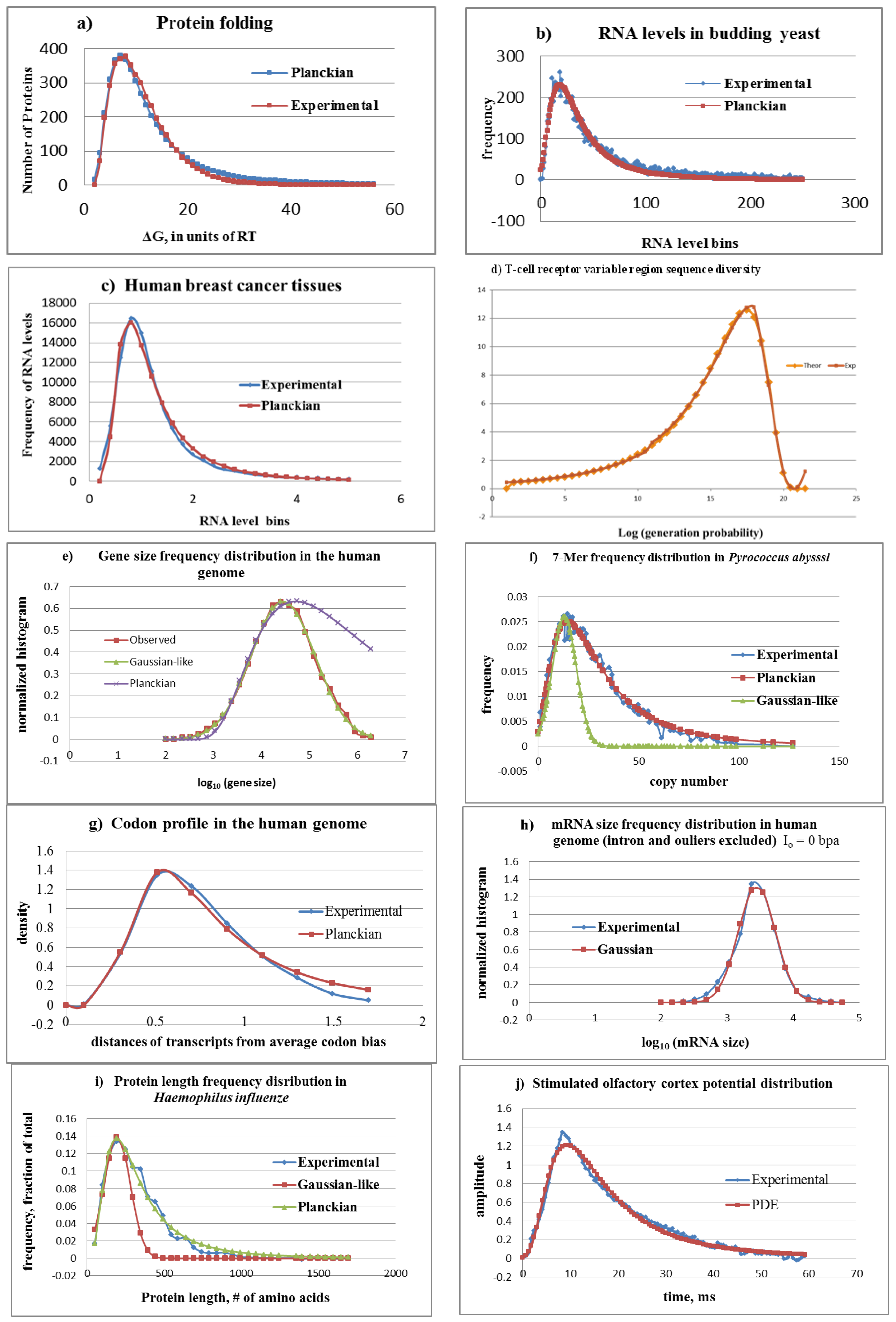
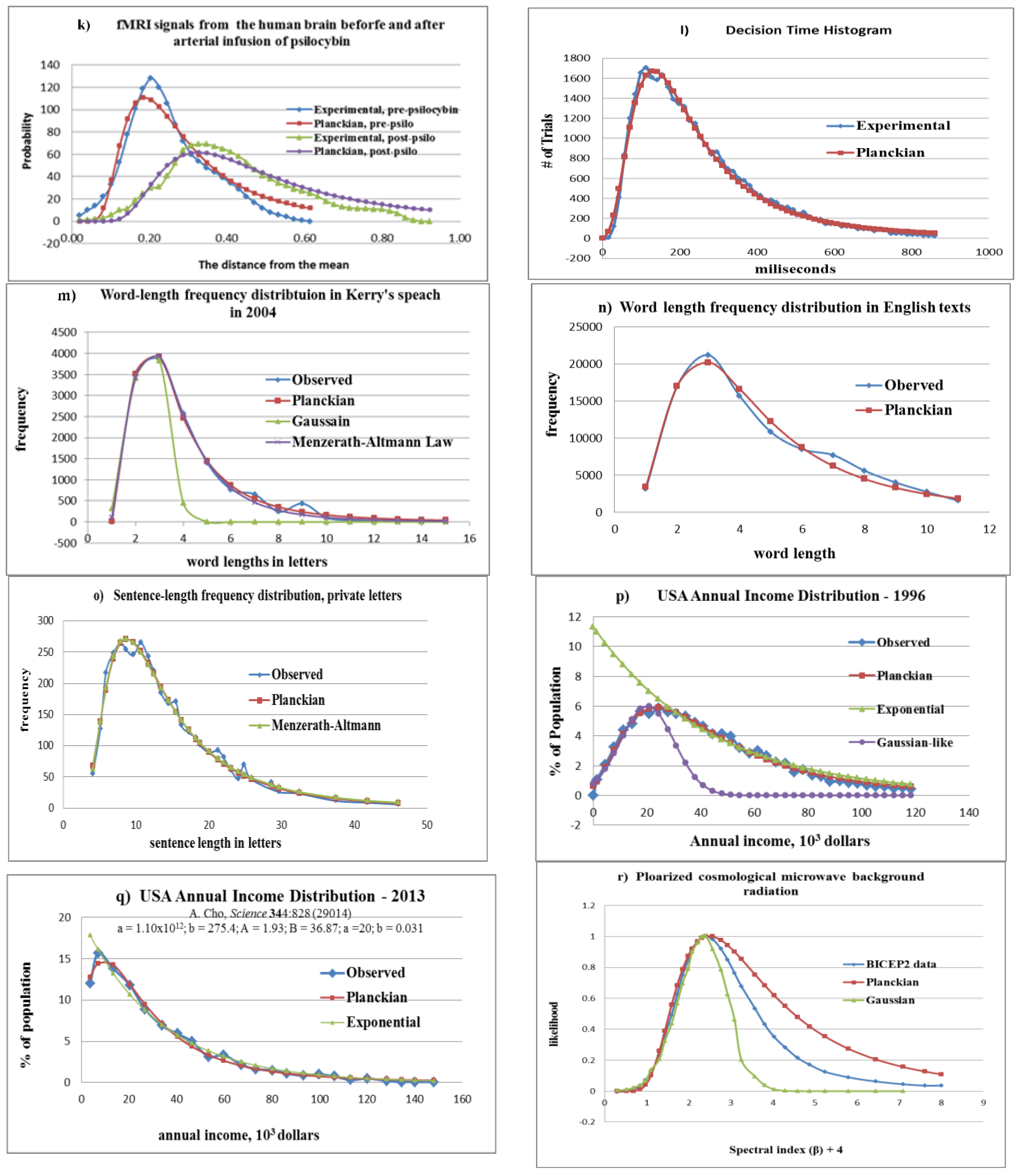


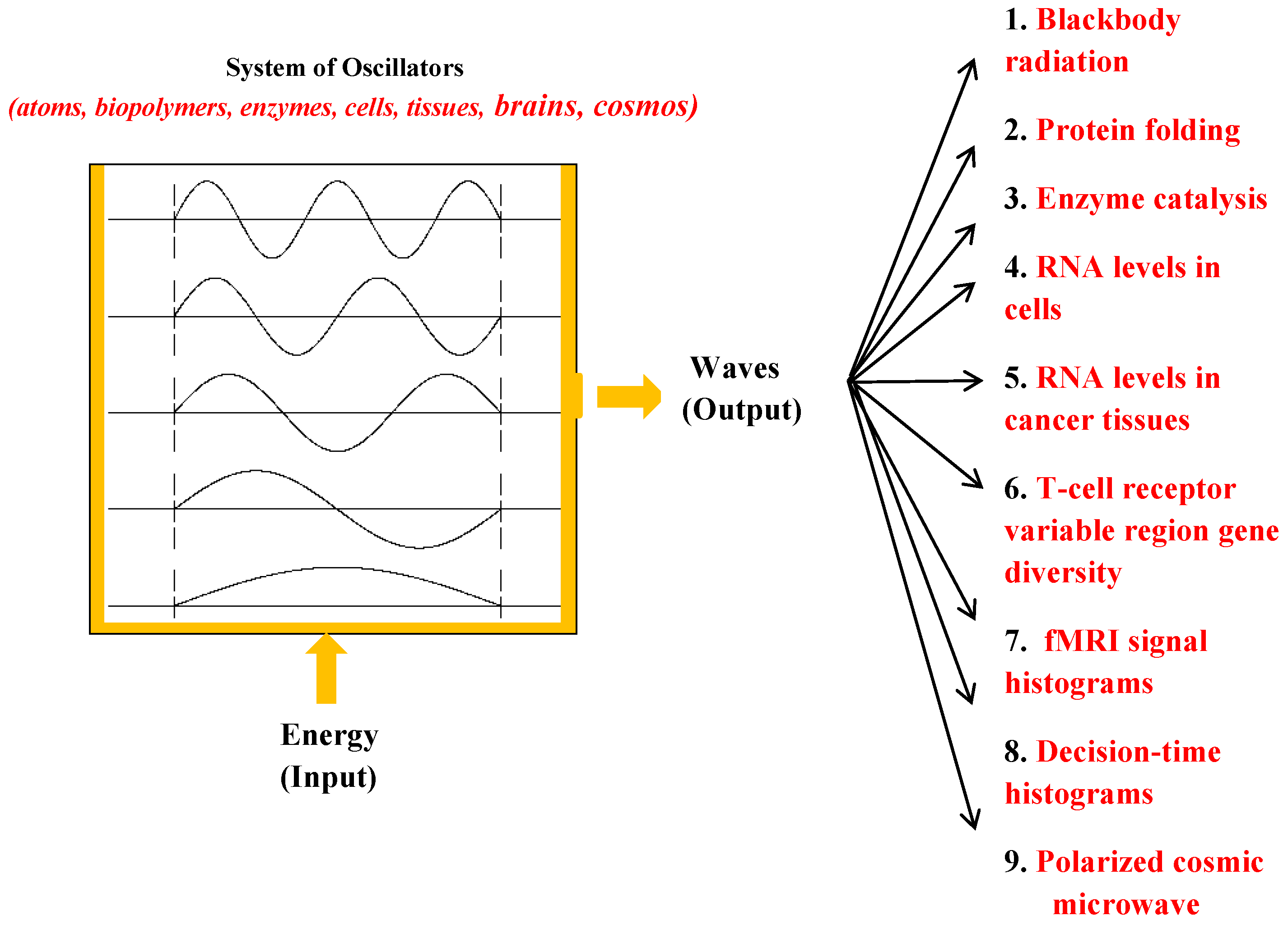

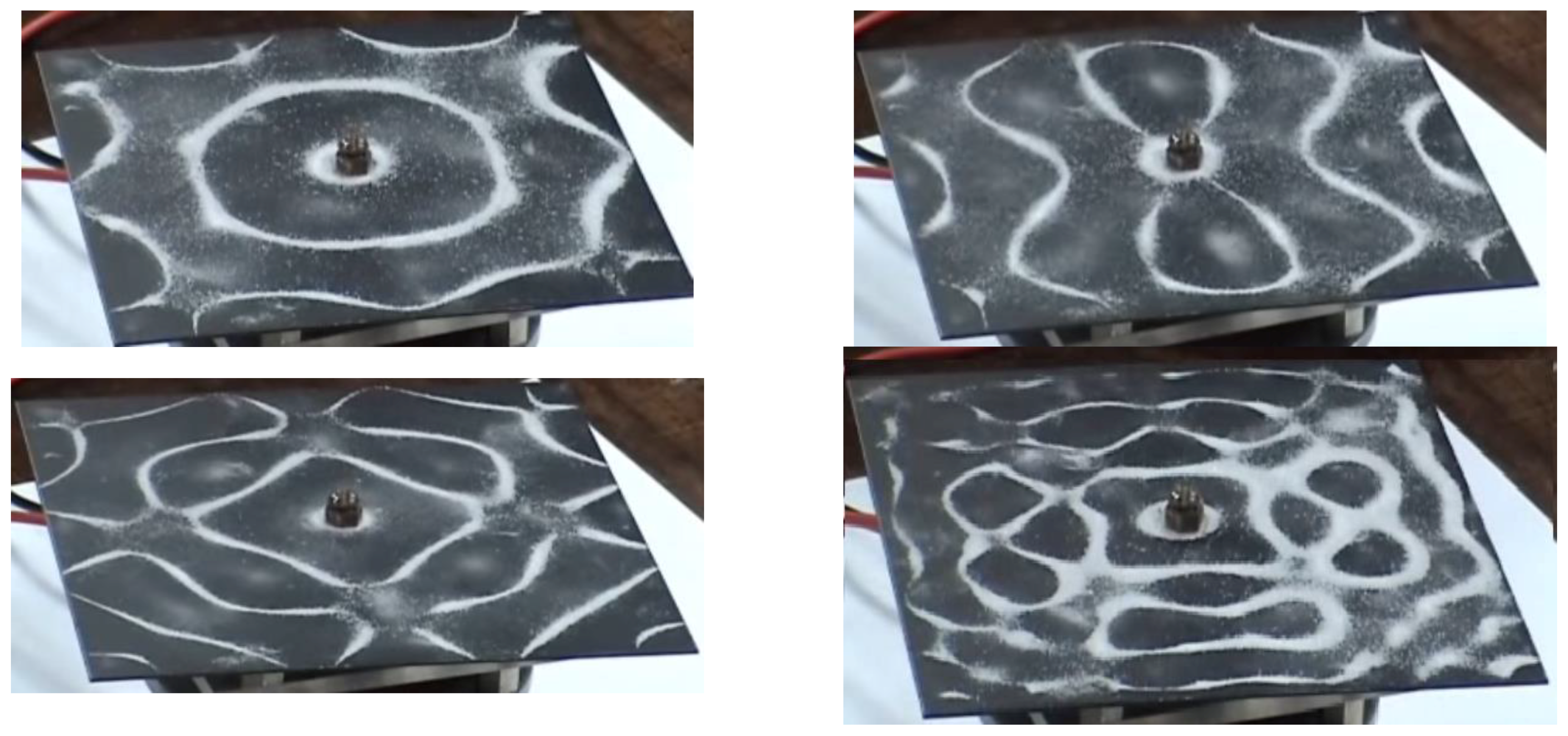
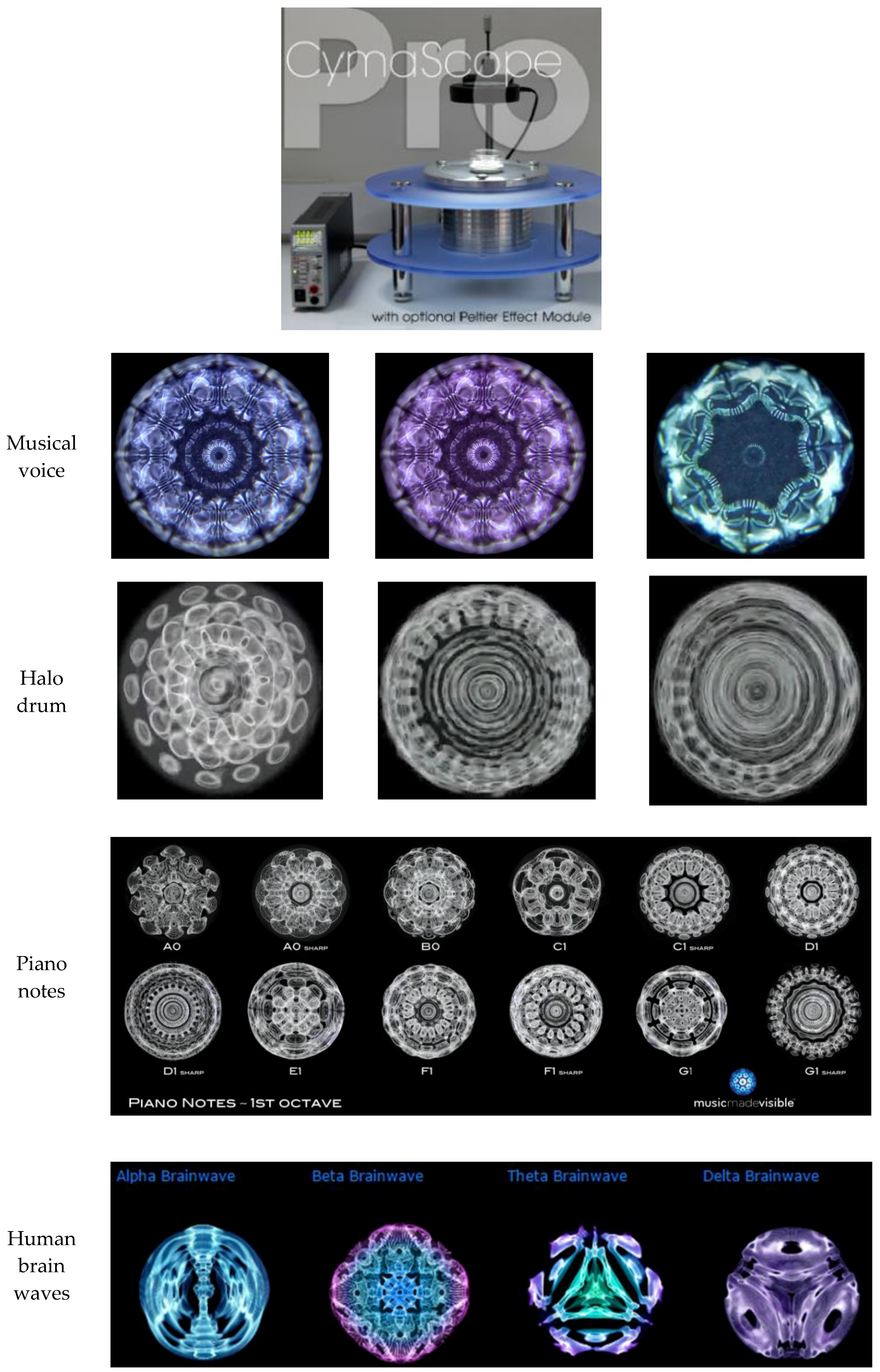
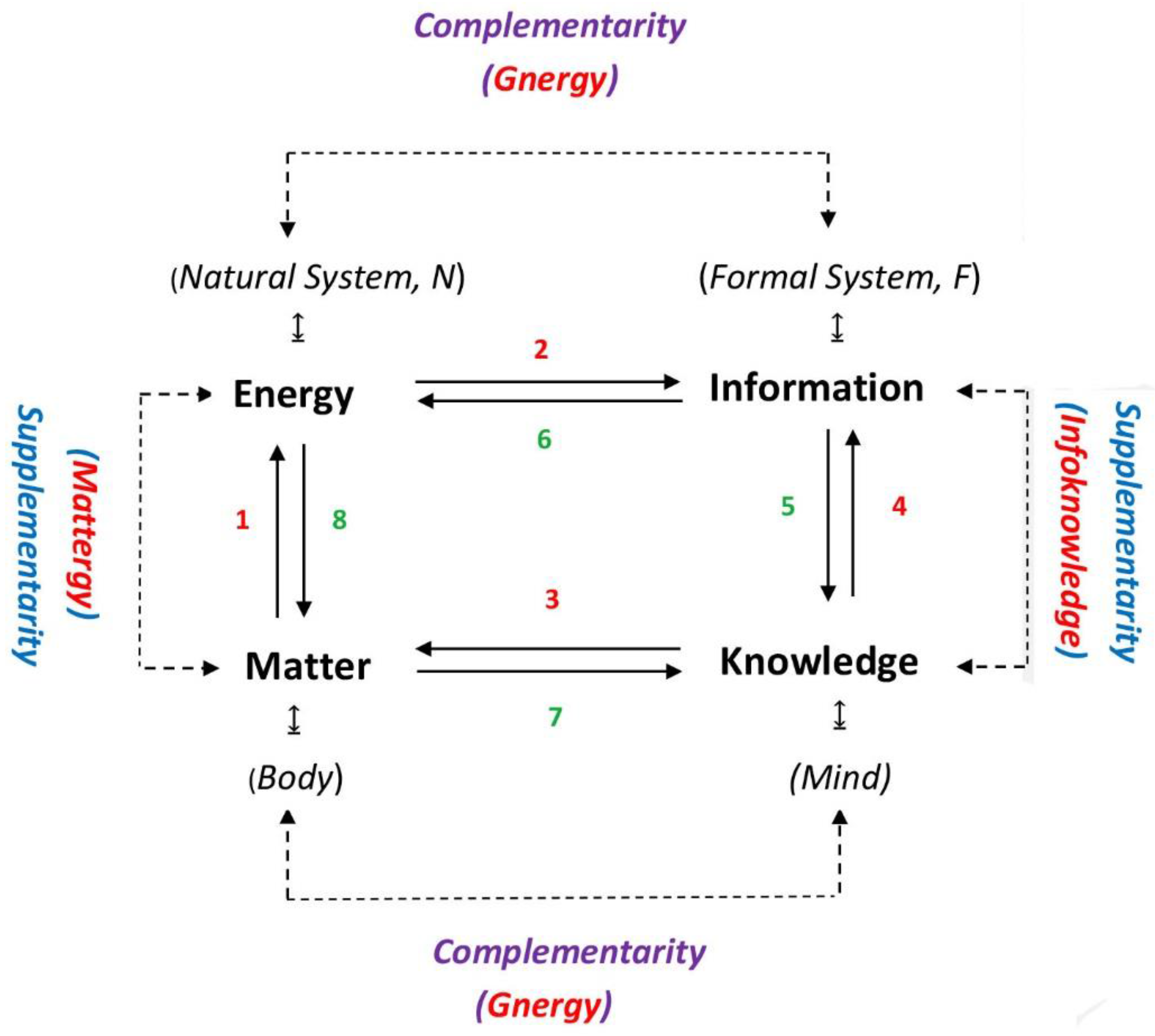
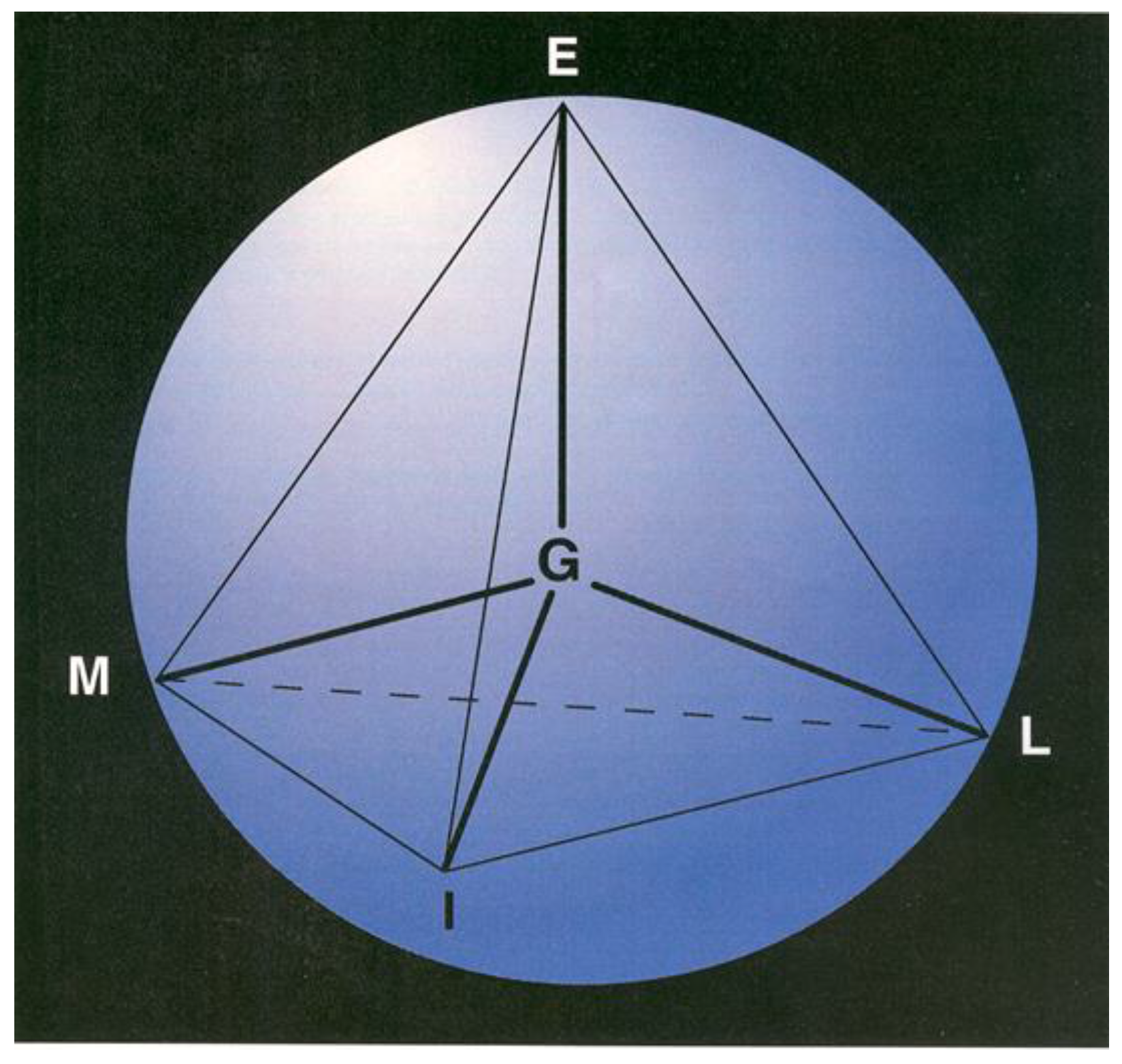
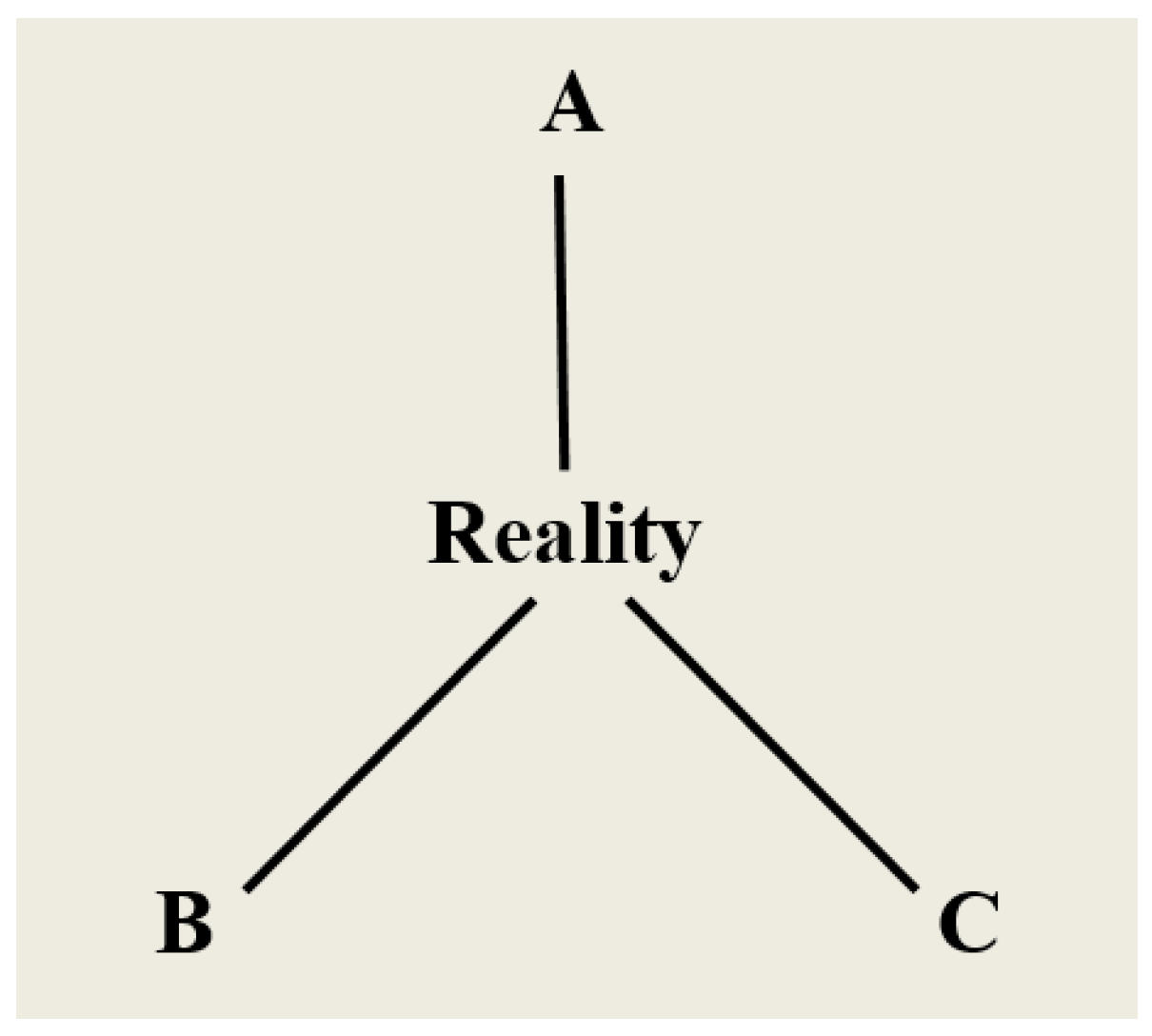
| Physics | Biology | |
|---|---|---|
| Supplementarity (from Special Relativity Theory) | 1. Matter-Energy Equivalence E = mc2 | 6. Life-Information Equivalence a |
| 2. Matter-Energy or “Mattergy” b | 7. Life-Information or “Liformation” c | |
| 3. “Matter is a highly condensed form of energy.” | 8. “Life is a highly condensed form of information.” | |
| Complementarity (from Quantum Mechanics) | 4. Wave-Particle d Complementarity; Kinematics-Dynamics Complementarity e | 9. “Liformation–Mattergy” Complementarity |
| 5. “Wavicles” or “Quons” f | 10. “Gnergons” g |
| Synonymous Codon Usage | Codon Profile | ||||
|---|---|---|---|---|---|
| CGT | 8% | base | Position in the triplet | ||
| CGC | 19% | 1 | 2 | 3 | |
| CGA | 11% | T | 0 | 0 | 0.08 |
| CGG | 21% | C | 0.59 | 0 | 0.19 |
| AGA | 21% | A | 0.41 | 0 | 0.32 |
| AGG | 20% | G | 0 | 1 | 0.41 |
| sum | 100% | sum | 1 | 1 | 1 |
| Histogram | a | b | A | B | C | b/A, IP (mb) * |
|---|---|---|---|---|---|---|
| (a) Protein folding | 1.24 × 1014 | 368.3 | 9.45 | 6.82 | - | 38.97, 0.877 |
| (b) RNA levels (yeast) | - | - | 1.11 × 1012 | 13.962 | 159.30 | -, 0.989 |
| (c) RNA levels (breast tissue) | 8 × 1010 | 40 | 8 | 1.7 | - | 5.00, 0.855 |
| (d) T-Cell receptor | - | - | 7.02 × 106 | 0.063 | 25.00 | -, - |
| (f) 7-Mer frequency | - | - | 5.05 × 107 | 12.123 | 123.78 | -, 0.873 |
| (i) Protein chain length | - | - | 2.04 × 1013 | 5.655 | 1257.4 | -, 0.846 |
| 5.0 × 1011 | 601.7 | 0.478 | 30.29 | - | 1257.7, - | |
| (l) Decision times | 8.5 × 1011 | 101.49 | 0.1077 | 6.345 | - | 942.34, 3.57 |
| (k) fMRI signals | 7.6 × 1010 4.4 × 1010 | 107.67 43.17 | 115.9 26.7 | 0 0 | - - | 0.928, 1.04 1.617, 1.31 |
| (m) Word length in speech | - | - | 1.80 × 107 | −0.001 | 12 | -, 0.557 |
| (o) Sentence length in letters | - | - | 3.11 × 109 | 0.861 | 47.57 | -, 0.664 |
| (r) Cosmos | 3.6 × 102 | 6.00 | 1.140 | −0.14 | - | 4.65, - |
| 1. Concept | Entropy (1) | Quanta (2) | Information (3) |
| 2. Field of study | Thermodynamics | Quantum mechanics | Informatics |
| 3. Experiment/Measurement | S = ΔQ/T | Blackbody radiation spectra | Selecting m out of n possibilities or choices |
| 4. Statistical, mechanical formulations | S = −k Σ pi log pi Boltzmann–Gibbs entropy (1866) * | U(λ,T) = (2πhc2/λ5)/(ehc/λkT − 1), Planck radiation equation (PRE) (1900) | IP = log2(AUC(P)/AUC(G)), where IP = Planckian information, AUC = area under curve; P = PDE, and G = Gaussian-like equation, i.e., y = Ae−(x − µ)^2/(2σ^2) |
| 5. Mathematical formulation | H = −K Σ pi log pi Shannon entropy (1948) | y = (a/(Ax + b)5)/(eb/(Ax + B) − 1), Planckian distribution equation (PDE) (2008) | I = A log2 (n/m) A unified theory of the amount of information (2015a, c) |
| 6. Emerging Concept | A measure of DISORDER | Quantization of action Essential for ORGANIZATION | A measure of the ORDER of an organized system |
© 2017 by the authors. Licensee MDPI, Basel, Switzerland. This article is an open access article distributed under the terms and conditions of the Creative Commons Attribution (CC BY) license ( http://creativecommons.org/licenses/by/4.0/).
Share and Cite
Ji, S. Waves as the Symmetry Principle Underlying Cosmic, Cell, and Human Languages. Information 2017, 8, 24. https://doi.org/10.3390/info8010024
Ji S. Waves as the Symmetry Principle Underlying Cosmic, Cell, and Human Languages. Information. 2017; 8(1):24. https://doi.org/10.3390/info8010024
Chicago/Turabian StyleJi, Sungchul. 2017. "Waves as the Symmetry Principle Underlying Cosmic, Cell, and Human Languages" Information 8, no. 1: 24. https://doi.org/10.3390/info8010024





